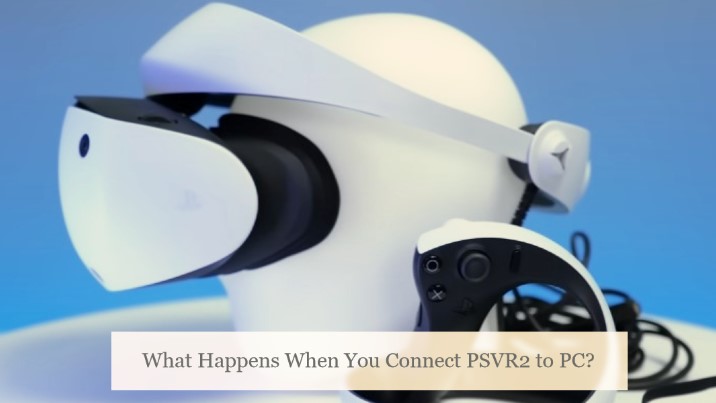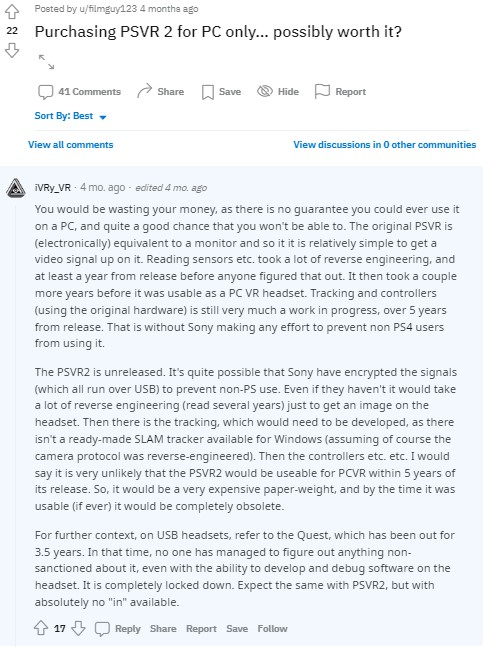With the arrival of the PlayStation VR2, PS5 owners can now enjoy console-quality VR games such as Gran Turismo 7, Horizon Call of the Mountain, No Man’s Sky, and Resident Evil Village, thanks to the impressive hardware it packs. And despite the hefty $550 launch price tag, it has garnered an immensely positive reception so far.
However, like you, many are left wondering whether it’s possible to connect PSVR2 to a VR-capable gaming PC. After all, the original PSVR works as a secondary monitor when connected to a computer. And with the proper software, one can also use it for SteamVR.
Sadly, connecting the PSVR2 to a PC and gaining access to SteamVR titles isn’t currently supported, leading to disappointment for some potential buyers. This article explains what happens when you connect PSVR2 to PC and why the headset is unlikely to ever work outside its own ecosystem.
What Happens When You Connect PSVR2 to PC?

As reported by The Verge, the team took the opportunity to test their PlayStation VR2 review unit’s compatibility with a PC rocking an AMD RX 6800 XT graphics card, utilising its USB-C port to get video output.
Their findings reveal that the headset is functional and serves as a secondary screen, albeit at a restricted resolution of 1080p, four times lower than the device’s potential. And to no one’s surprise, SteamVR doesn’t recognise the PSVR2 headset.
Furthermore, the video signal transmitted through the PSVR2’s USB-C cable lacks encryption, most likely to eliminate extra latency. And the lack of drivers makes the headset impractical to use with a gaming PC, rendering it nothing more than a “fancy second screen”.
Connecting the PSVR2’s controllers to a PC via USB is possible. What’s surprising is that they show up as “HID-compliant game controllers” in Device Manager, indicating potential for future mods.
Why is PSVR2 Unlikely to Ever Work with PCs?
Similar to the OG headset, the PSVR2 brings additional value to the PlayStation ecosystem, which Sony believes will incentivise gamers to prefer it over its fierce competition against Microsoft and Nintendo.
While Microsoft, with its Xbox Series consoles, offers the Xbox Game Pass and support for a massive back-catalogue of titles from the previous generations, PlayStation arguably boasts superior first-party exclusives with a loyal fanbase. Throw in a VR headset and some killer apps into the mix, and Sony’s giving gamers a more cost-effective solution than having an Xbox and a separate gaming PC for VR.
It’s no secret that Sony and Microsoft sell consoles with minimal profit margins or even at loss. Their primary revenue streams are their live services and the percentage they earn from game sales on their respective storefronts. Should the PSVR2 be compatible with SteamVR, Sony would essentially be handing out their software profits to Valve without any meaningful return on their investment.
We won’t be surprised if Sony is working on its own PCVR platform, especially now that PlayStation has a PC division, though certain hardware factors make this scenario improbable.
For instance, PSVR2 utilises a single USB-C cable to transmit video and real-time tracking data simultaneously. Therefore, PCVR compatibility would necessitate specialised driver support or, at the very least, some sort of adapter.
Additionally, it would require Sony to port the tracking system and modify the core rendering architecture to accommodate another operating system like Windows and support a vast array of hardware, which took Oculus, HTC, and Valve a few years to accomplish.
Sony currently releases its first-party, non-VR titles on Steam to reach another enormous group of gaming audiences and boost sales. However, extending support for PSVR2 on PC would present a considerably smaller opportunity, demanding significant work for a niche payoff.
What do the Modders have to Say?
Interestingly, the original PSVR headset is compatible with SteamVR via third-party tools like iVRy and Trinus. Incorporating PSVR2 with SteamVR appears less feasible nonetheless, due to the unique technical challenges, as explained by u/iVRy_VR on Reddit.

As highlighted by the developer of iVRy, the first-gen PSVR was essentially a monitor along with an array of LEDs tracked by a pair of cameras. It took them a while and some tacky reverse engineering to get the readings from PSVR’s sensors on the PC.
Even six years in, the open-source webcam tracking solutions are inferior to Sony’s official tech on the PlayStation 4. Plus, people using the original PSVR on their PC don’t utilise positional tracking, opting instead only as a rotation-only headset for stationary games and flight sims.
As mentioned previously, the PlayStation VR2 uses a single USB-C connection carrying both video and tracking data, meaning it would be challenging to separate them without specialised hardware or drivers. Even assuming that modders manage to get around the video output issue, enabling tracking would be even more difficult.
The PlayStation VR2 does inside-out eye tracking, so modders need to determine how the cameras work, figure out the communication protocols, and reverse-engineer the data format. Even if they achieve all this, most openly-available tracking algorithms aren’t suitable for VR due to high latency and imprecise tracking – meaning it’s either that or someone has to build it from scratch.
All these obstacles are potentially solvable, and it isn’t totally out of the blue that the tinkerers’ community will eventually get around. But it’ll prove extremely difficult and time-consuming, potentially taking several years of dedicated effort.
Moreover, by the time modders figure all that out (if ever), there will likely be more advanced VR headsets available on the market, with official PC support, and likely at a lower cost than the PSVR2.
Also See: Meta Quest 3 Release Date, Price, Features, Design & More
In Summary
Connecting PSVR2 to PC isn’t possible at the time of writing – and probably not in the foreseeable future either. The news may leave some of you crestfallen because, for its $550 retail price and impressive hardware, the PlayStation VR2 could have very well been a no-brainer for PCVR.
Until somebody gets it working with PC, if ever, the next-gen PSVR2 headset remains an exclusive add-on for PlayStation 5 owners only.